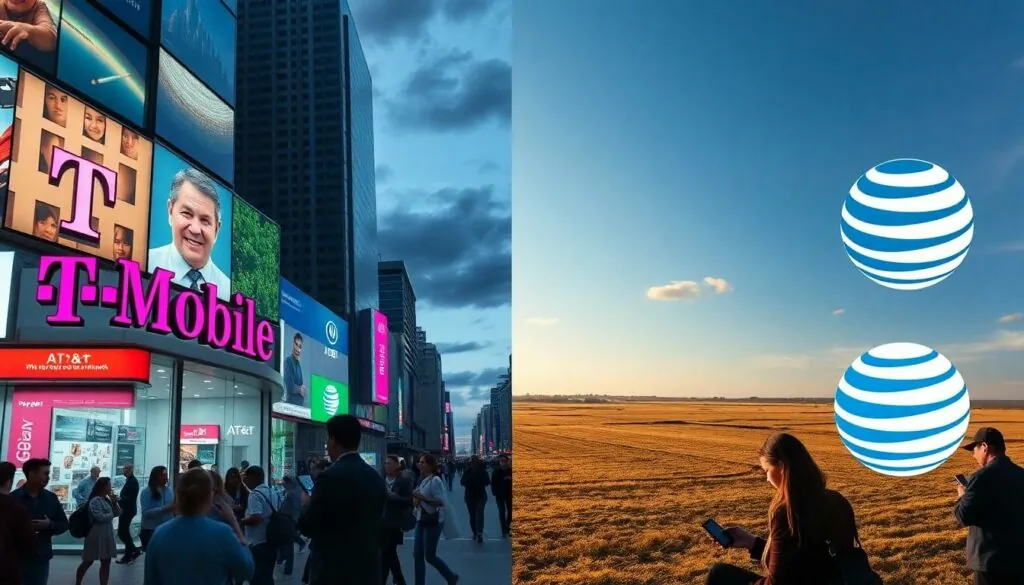Table of Contents
ToggleIn the epic showdown of AT&T vs T-Mobile, consumers are left scratching their heads and checking their wallets. Both giants promise lightning-fast speeds and coast-to-coast coverage, but which one really reigns supreme? It’s like choosing between a juicy steak and a perfectly grilled veggie burger—both have their merits, but only one might satisfy your cravings.
With plans that can make your head spin and customer service stories that could fill a novel, making the right choice can feel like an Olympic sport. So whether you’re a data-hungry binge-watcher or just want to make sure your memes load faster than your neighbor’s Wi-Fi, this comparison will break down the essentials. Get ready to dive into the nitty-gritty of coverage, pricing, and perks, and find out which carrier will keep you connected without breaking the bank.
Overview of AT&T and T-Mobile
AT&T features a vast network with solid coverage across urban and rural areas. This telecommunications provider offers a variety of plans tailored to different customer needs. Through its commitment to both 4G LTE and 5G technologies, customers experience improved connectivity and speed.
T-Mobile stands out for its innovative pricing structures and customer-centric approach. With an expanding 5G network, it aims to cover a significant number of consumers in densely populated regions. Additionally, its focus on no annual service contracts attracts many users looking for flexibility.
While AT&T emphasizes comprehensive multimedia options and bundling services, T-Mobile often promotes unlimited data plans with no deprioritization during congestion periods. Both carriers invest in customer support initiatives to enhance user experiences.
Pricing differences between the two are notable. AT&T typically charges more for premium services, while T-Mobile’s competitive rates often draw budget-conscious customers. Monthly plans vary significantly, making it essential for consumers to compare specific offerings.
Overall, AT&T and T-Mobile each provide unique advantages. Deciding between the two largely depends on individual preferences related to coverage, price, and what additional features matter most. Both companies continue to evolve, aiming to meet the demands of a rapidly changing telecommunications landscape.
Network Coverage

Network coverage directly impacts user experience and accessibility. Both AT&T and T-Mobile have made significant strides in enhancing their coverage areas.
AT&T Coverage Evaluation
AT&T provides extensive network coverage, especially in urban areas. Users often notice strong signal strength in cities. Rural regions also benefit from AT&T’s investment in infrastructure. According to industry reports, approximately 68% of the U.S. population accesses AT&T’s network. 4G LTE coverage remains robust, while 5G expansion continues to improve connectivity options. Various devices, including smartphones and tablets, efficiently connect to the network.
T-Mobile Coverage Evaluation
T-Mobile emphasizes its growing coverage, particularly in densely populated environments. The carrier recently reported about 99% 4G LTE coverage nationwide, showcasing its commitment to widespread accessibility. Cities experience excellent service quality due to T-Mobile’s focused investments. Rural areas, however, may have limited coverage compared to AT&T. As it rapidly develops its 5G infrastructure, T-Mobile aims for enhanced user experience, ensuring more users gain access to faster connectivity.
Plans and Pricing
Comparing plans and pricing for AT&T and T-Mobile reveals distinct options tailored to diverse customer needs.
AT&T Plans and Pricing
AT&T offers several plans catering to various budgets and usage habits. Customers find options starting at around $30 per month for basic services, which include limited data. Premium plans start at approximately $70 per month, featuring unlimited data and access to robust multimedia options. AT&T frequently promotes family plans, making it affordable for multiple lines. Notably, subscribers enjoy access to HBO Max, enhancing value for entertainment seekers. AT&T also provides discounts for eligible military personnel and first responders.
T-Mobile Plans and Pricing
T-Mobile embraces a competitive pricing strategy designed for savings-conscious customers. Plans begin at about $60 per month for unlimited data without deprioritization during network congestion. Family plans attract users with discounts, making it economical to add multiple lines. T-Mobile often includes features like Netflix and international calling options, appealing to frequent travelers. Pricing transparency means no hidden fees, allowing customers to budget accurately. Special promotions occasionally provide even lower rates, enhancing its appeal.
Data Speeds and Performance
Data speeds significantly influence the consumer experience with AT&T and T-Mobile. Each carrier offers different performance metrics that can affect users’ day-to-day activities.
Comparisons of Data Speeds
T-Mobile delivers impressive average download speeds, reaching about 104 Mbps in urban settings. AT&T’s download speeds also rank highly, averaging around 64 Mbps. During peak hours, T-Mobile often maintains faster speeds due to its advanced 5G network and capacity management strategies. Utilization of the mid-band spectrum allows T-Mobile to optimize performance in crowded areas. AT&T’s extensive 4G LTE backbone supports reliable speeds, particularly in less congested environments.
Performance Analysis
Network reliability plays a crucial role for users. Both AT&T and T-Mobile achieve strong performance ratings across various geographic locations. Measurements indicate AT&T demonstrates better reliability in rural areas, while T-Mobile excels in urban environments. Fewer dropped calls are reported by T-Mobile customers in metropolitan areas. Both carriers utilize extensive infrastructure investments, ensuring consistent connectivity. In high-traffic zones, T-Mobile might provide superior speeds, supporting a better user experience overall. AT&T, however, continues to enhance its network capabilities, focusing on maintaining high-speed connections across its coverage areas.
Customer Service
Customer service plays a crucial role in the experience customers have with AT&T and T-Mobile. Understanding how each company supports its customers helps in making informed decisions.
AT&T Customer Support
AT&T provides multiple channels for customer support, including phone, chat, and in-store assistance. They offer 24/7 support for urgent issues, ensuring customers receive timely help. Online resources such as tutorials and a community forum enhance the support experience. Approximately 70% of customers report satisfaction with the assistance received, reflecting AT&T’s commitment to addressing concerns promptly.
T-Mobile Customer Support
T-Mobile focuses on accessibility and convenience in customer service. Live chat and social media support make it easier for customers to get help. Support representatives are available 24/7, with many cases resolved efficiently. According to surveys, about 86% of customers express satisfaction with T-Mobile’s service, emphasizing their customer-friendly approach. Unique for lacking annual contracts, T-Mobile’s policies further foster a positive service experience.
Choosing between AT&T and T-Mobile ultimately hinges on personal preferences and priorities. Those who value extensive rural coverage and a variety of plan options may lean toward AT&T. Its strong signal strength and competitive pricing cater well to diverse customer needs.
On the other hand, T-Mobile appeals to users who prioritize speed and innovative pricing without hidden fees. With its impressive urban performance and added perks like Netflix, it’s a great choice for frequent travelers and those seeking straightforward plans.
Both carriers have their strengths and weaknesses. By carefully assessing coverage, pricing, and customer service, individuals can find the right fit for their telecommunications needs.




